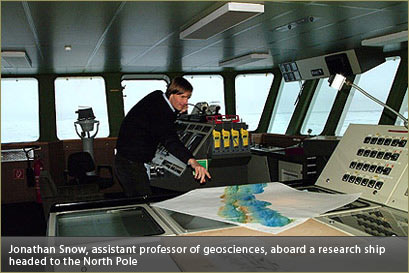
By Rolando Garcia
Natural Sciences and Mathematics Communications
What a University of Houston geologist discovered during an expedition to the North Pole is perhaps even more astonishing than Santa Claus or flying reindeer – ancient, never-before-seen mantle rocks that give scientists a rare glimpse deep into the Earth's interior.
These two billion-year-old rocks that time forgot were found along the bottom of the Arctic Ocean floor by a team of researchers led by Jonathan Snow, assistant professor of geosciences at UH. The discovery could shed new light on the mantle, the vast layer that lies beneath the planet’s outer crust.
Snow and his team published their findings in the March 20 issue of Nature, one of the world’s leading scientific journals. The rocks were unearthed during research voyages in 2001 and 2004 to the Gakkel ridge, an approximately 1,000-mile-long underwater mountain range that forms the border between the North American and Eurasian plates beneath the Arctic Ocean.
The mantle, the rock layer that comprises about 70 percent of the Earth’s mass, sits several miles below the planet’s surface. Mid-ocean ridges like Gakkel, where mantle rock is slowly pushing upward to form new volcanic crust as the continental plates slowly move apart, is one place geologists look for clues about the mantle.
Gakkel Ridge is unique because it features – at some locations – the least volcanic activity and most mantle exposure ever discovered on a mid-ocean ridge. This allowed Snow and his colleagues to recover many mantle samples in 2001 and 2004.
These were the first major expeditions ever undertaken to the Gakkel Ridge, and the findings published in Nature are the fruit of several years of research and millions of dollars spent to retrieve and analyze these rocks.
Aboard a 400-foot-long research vessel designed to break through the ice, Snow and his team would sift through hundreds and hundreds of pounds of rocks that had been scooped up from the ocean floor by the ship’s dredging device.
The samples had to be labeled and cataloged and then cut into slices thinner than a human hair so they could be examined under a microscope. That is when Snow realized that he had found something that, for many geologists, is as rare and fascinating as moon rocks – mantle rocks devoid of sea floor alteration. Analysis of the isotopes of osmium, a noble metal rarer than platinum, indicated the samples were two billion years old.
Because the mantle is slowly moving and churning within the Earth, geologists believe the mantle is a layer of well-mixed rock. Fresh mantle rock wells up at ridges to create new crust. As the continental plates move, this crust slowly makes its way to a subduction zone, a plate boundary where one plate slides underneath another and the crust is pushed back into the mantle from which it came.
This whole process takes about 200 million years, and so it was surprising to find rocks that had not been remixed inside the mantle for two billion years.
“I just about fell off my chair,” Snow said. “We can’t exaggerate how important these rocks are – they’re a window into that deep part of the Earth.”
The discovery of the rocks suggests the mantle is not as well-mixed or homogenous as geologists previously believed, Snow said. The Earth’s mantle thus preserves an older and more complex geologic history than previously thought.
The rocks were found during two expeditions Snow and his team made to the Arctic, each lasting about two months. The voyages were undertaken while Snow was a research scientist at the Max Planck Institute in Germany. The laboratory study was done by his research team, which now stretches from Hawaii to Houston to Beijing.
Since coming to UH in 2005, Snow’s work stemming from the Gakkel ridge samples has continued. More research is needed to determine exactly why these rocks remained unmixed for so long, Snow said. Further study using a laser microprobe technique available only in Australia is planned for next year. |

